What is Shoulder Reconstruction?
Shoulder reconstruction is a surgical procedure performed in patients with shoulder instability to improve stability, restore the function and prevent recurrent dislocations of the shoulder joint.
What conditions does Shoulder Reconstruction help?
Shoulder reconstruction is performed to treat shoulder instability and shoulder dislocation Shoulder instability is a problem of loose shoulder joint that occurs when the structures that surround the shoulder joint such as the ligaments, capsule and cartilage become overstretched or injured. When this occurs, you may have shoulder joint dislocation. A dislocation occurs when the head of the upper arm bone (humerus) is forced out of the shoulder socket (glenoid). Shoulder dislocation can be partial or complete. A partial dislocation occurs when the ball of the upper arm comes partially out of the socket. It is referred to as a subluxation. A complete dislocation occurs when the ball comes all the way out of the socket.
Shoulder instability most commonly occurs as a result of a Bankart injury or tear. Bankart tear is a specific injury to a part of the shoulder joint called the labrum. Labrum is a ring of fibrous cartilage that surrounds the glenoid and stabilizes the shoulder joint. Bankart tear leads to recurrent dislocations, feeling of looseness, lack of strength, pain or clicking and arthritis of the shoulder. Shoulder instability may be caused by injury, falling on outstretched hand, repetitive overhead sports such as basketball, volley ball or weight lifting.
Why is Shoulder Reconstruction Required?
Untreated shoulder instability/dislocation may result in severe pain, swelling, popping or grinding sound, partial or complete dislocation, loss of sensation or partial paralysis and loss of function. If conservative treatment such as immobilization, prescription medicines, physical therapy, closed reduction or manipulation and occupational therapy fails to relieve the shoulder instability, your surgeon may recommend reconstruction surgery.
Who is Shoulder Reconstruction Suitable For?
Shoulder reconstruction is suitable for anyone with an active lifestyle who has suffered a shoulder injury involving the ligament, tendon, cartilage, or bone that has failed conservative management.
Preparation before Shoulder Reconstruction
In preparation for the surgery, you should inform your doctor about any medications you are currently on. Some medications may have to be temporarily discontinued before the procedure. Complete as much of your household chores as possible as you will have limited use of one arm for at least a week after the procedure. You should stop eating or drinking at midnight on the day before surgery.
Day of Shoulder Reconstruction
On the day of treatment, bring a shirt with you that has buttons down the front, so you don’t have to lift your arm up while putting it on. You will be given a hospital gown to change into as well as regional and/or general anaesthesia. The procedure usually lasts about an hour and can be performed in a hospital or outpatient setting.
What happens during the Shoulder Reconstruction Procedure?
Shoulder reconstruction surgery involves repair of the torn or stretched ligaments so that they are better able to hold the shoulder joint in place. During the surgery, the torn labrum is reattached back to the shoulder socket with the help of special anchors and the overstretched capsules and ligaments are tightened.
Shoulder reconstruction surgery can be done arthroscopically that involves use of smaller incisions and tiny instruments to perform the repair. Some patients may need an open surgical procedure which involves a larger incision over the shoulder to perform the repair.
Immediately after Shoulder Reconstruction
Immediately after the shoulder reconstruction you will be taken to the recovery room for monitoring until the anaesthesia wears off. Most patients can return home on the same day as the surgery.
What Should I expect after Shoulder Reconstruction?
Following surgery, your arm is kept in a sling for four to six weeks to facilitate healing. Your physiotherapist will show you use of the sling and instruct on simple exercises. You may have slight pain after surgery for which pain medications are prescribed. Apply ice packs on the shoulder to help reduce the swelling. You can use a pillow under your shoulder while lying in bed. Avoid heavy lifting and driving during the first 6 weeks. You will be given specific instructions regarding activity and a rehabilitation program of exercise and strengthening.
Possible Risks and Complications of Shoulder Reconstruction
Complications are rare after shoulder reconstruction surgery. Some of the common complications include infection, stiffness or restricted movement, nerve and vessel injury, failure of the procedure and side effects of general anaesthesia.
Alternatives to Shoulder Reconstruction
Other alternatives to shoulder reconstruction include shoulder stabilization surgery and shoulder replacement surgery.

